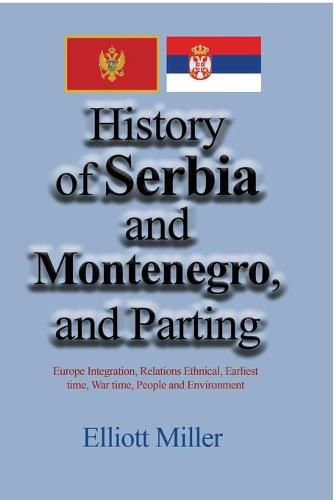Readings Newsletter
Become a Readings Member to make your shopping experience even easier.
Sign in or sign up for free!
You’re not far away from qualifying for FREE standard shipping within Australia
You’ve qualified for FREE standard shipping within Australia
The cart is loading…






This title is printed to order. This book may have been self-published. If so, we cannot guarantee the quality of the content. In the main most books will have gone through the editing process however some may not. We therefore suggest that you be aware of this before ordering this book. If in doubt check either the author or publisher’s details as we are unable to accept any returns unless they are faulty. Please contact us if you have any questions.
History of Serbia and Montenegro, and Parting. Europe Integration, Relations Ethnical, Earliest time, War time, People and Environment. Together with east-central Europe, the Balkans formed the heartland of an Old European civilization that flourished between 7000 and 3500 BC. There is evidence of dense settlement, particularly in the Pannonian Basin, along the Sava and Danube rivers, and spreading northward into modern Hungary along the Tisa and southward down the Morava-Vardar corridor. Food production had developed to the point that it was possible to support a measure of craft specialization, including pottery making and the smelting of copper, and small towns were formed. Several important sites in Serbia provide insights into Old European culture, particularly those at Starcevo and Vinca, near Belgrade, and at Lepenski Vir, on the Danube above the Iron Gate. After 3500 BC the region was gradually infiltrated by seminomadic pastoral peoples, believed to be speakers of languages of the Indo-European family, who came southward and westward from the Russian steppes. Their extensive trade routes carried amber, gold, and the bronze that was the basis of their superior military technology. These peoples were divided into tribal groups, one of which, the Illyrians, became firmly established throughout the western part of the peninsula. By the 7th century BC they had acquired the capacity to work with iron, and this skill became the basis both of their extensive trade with the emerging Greek city-states and of the power of the native aristocracies. East of the Morava-Vardar the land was periodically subordinated to the warrior kingdoms of the Dacians and Thracians
$9.00 standard shipping within Australia
FREE standard shipping within Australia for orders over $100.00
Express & International shipping calculated at checkout
This title is printed to order. This book may have been self-published. If so, we cannot guarantee the quality of the content. In the main most books will have gone through the editing process however some may not. We therefore suggest that you be aware of this before ordering this book. If in doubt check either the author or publisher’s details as we are unable to accept any returns unless they are faulty. Please contact us if you have any questions.
History of Serbia and Montenegro, and Parting. Europe Integration, Relations Ethnical, Earliest time, War time, People and Environment. Together with east-central Europe, the Balkans formed the heartland of an Old European civilization that flourished between 7000 and 3500 BC. There is evidence of dense settlement, particularly in the Pannonian Basin, along the Sava and Danube rivers, and spreading northward into modern Hungary along the Tisa and southward down the Morava-Vardar corridor. Food production had developed to the point that it was possible to support a measure of craft specialization, including pottery making and the smelting of copper, and small towns were formed. Several important sites in Serbia provide insights into Old European culture, particularly those at Starcevo and Vinca, near Belgrade, and at Lepenski Vir, on the Danube above the Iron Gate. After 3500 BC the region was gradually infiltrated by seminomadic pastoral peoples, believed to be speakers of languages of the Indo-European family, who came southward and westward from the Russian steppes. Their extensive trade routes carried amber, gold, and the bronze that was the basis of their superior military technology. These peoples were divided into tribal groups, one of which, the Illyrians, became firmly established throughout the western part of the peninsula. By the 7th century BC they had acquired the capacity to work with iron, and this skill became the basis both of their extensive trade with the emerging Greek city-states and of the power of the native aristocracies. East of the Morava-Vardar the land was periodically subordinated to the warrior kingdoms of the Dacians and Thracians